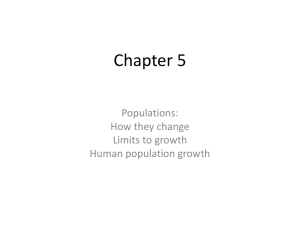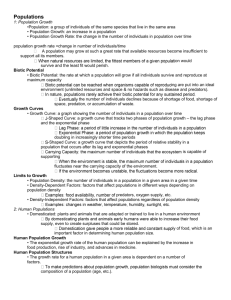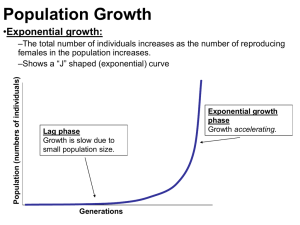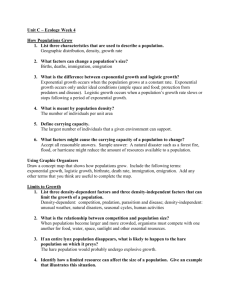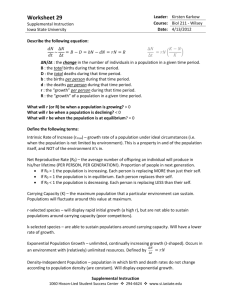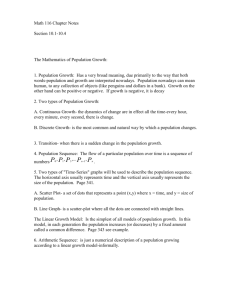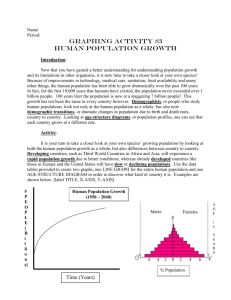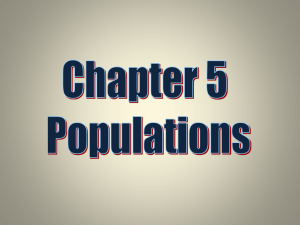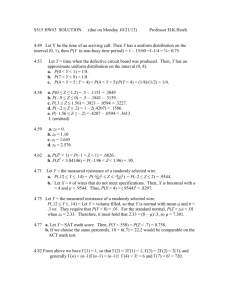Population: A group of organisms of the same species, living
advertisement
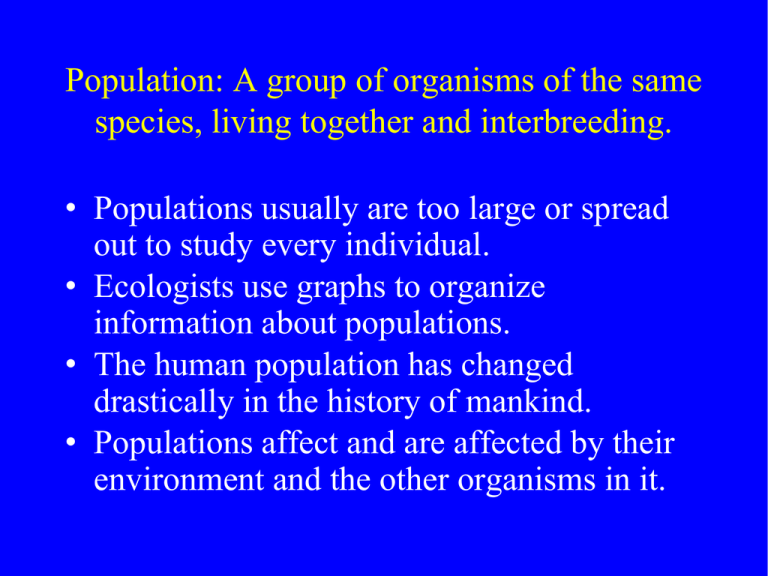
Population: A group of organisms of the same species, living together and interbreeding. • Populations usually are too large or spread out to study every individual. • Ecologists use graphs to organize information about populations. • The human population has changed drastically in the history of mankind. • Populations affect and are affected by their environment and the other organisms in it. Population Growth • Growth curve: graph showing the number of individuals in a population over time. • Biotic Potential: rate at which a population will grow if all individuals survive and reproduce at maximum capacity. Linear Growth Linear Growth: Growth that occurs in a straight line. (This generally doesn’t happen in nature.) Exponential Growth of Cells Exponential Growth: Growth at an ever-increasing rate; calculated using exponents. (The population has reached biotic potential) J-shaped curve Shows 2 phases: 1.Lag phase: little or no increase in population. 2.Exponential phase: period of exponential growth. (Can you label these on the graph?) http://www.biologycorner.com/bio4/notes/popgrowth.php S-shaped Curve Depicts limits on population due to environmental factors. Carrying capacity: maximum number of individuals that an ecosystem is capable of supporting. (Label lag phase, exponential phase and carrying capacity.) Limiting Factors: Variables in the environment that limit the growth rate. • Food • Disease • Forest Fires • Dutch Elm Disease • Kaibab deer • FIV virus: Evolutionary Arms Race- Wildcats Human Population Growth Demographic Trends Video Clip: Population Explosion Demography: the study of human population growth characteristics. Why is the human population so successful? 1. Better Sanitation. 2. Increased food productions (agriculture). 3. Control of disease. (medical technology) Growth Rate Birth Rate: the number of individuals being born into a population. Death Rate: The number of individuals dying from a population. The difference between the birth rate and death rate is the growth rate. population equilibrium • a situation in which the population stays at the same level, because the number of deaths is the same as the number of births The Population of the World The solid line in this graph shows estimates of the size of the world's population over the last two millennia. The estimates from 1800 to 1991 are based on more accurate data than those before. The dotted line shows what would happen if exponential growth continued to the year 2100. As you can see, the world's population has been growing exponentially (except during the years of the black death). How long will it continue to do so? (Since the graph was drawn, the world's population has reached 6.5 billion; that is, in 2007 we are still on course.) But can it continue indefinitely? Surely not. Influenza and Pneumonia Pandemic Excess Annual Death Rates from Influenza and Pneumonia: 1887-1921 Age Structure Graph that refers to portions of populations at different age levels. http://www.uwlax.edu/faculty/skala/Age-Structure.htm What does this graph tell us about the population? Is this population stable? Yes? http://www.uwlax.edu/faculty/skala/Age-Structure.htm How do we know? There are the same number of Prereproductive and post-reproductive individuals. http://www.uwlax.edu/faculty/skala/Age-Structure.htm In 1980, does country X exhibit an age structure more typical of a developing nation or an industrialized nation? Explain. What might account for the age structure predicted for the year 2080?
